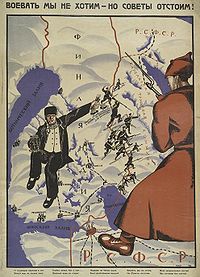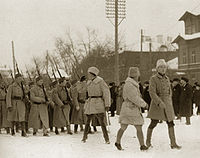
Heimosodat
Encyclopedia

Finland
Finland , officially the Republic of Finland, is a Nordic country situated in the Fennoscandian region of Northern Europe. It is bordered by Sweden in the west, Norway in the north and Russia in the east, while Estonia lies to its south across the Gulf of Finland.Around 5.4 million people reside...
historiography
Historiography
Historiography refers either to the study of the history and methodology of history as a discipline, or to a body of historical work on a specialized topic...
heimosodat in English literally "Kindred Nations Wars", "Wars for kindred peoples" or "Kinship Wars" for Finnic kinship. It is often erroneously translated as "Tribal
Tribe
A tribe, viewed historically or developmentally, consists of a social group existing before the development of, or outside of, states.Many anthropologists use the term tribal society to refer to societies organized largely on the basis of kinship, especially corporate descent groups .Some theorists...
Wars". It refers to conflicts in territories inhabited by other Baltic Finns
Baltic Finns
The Baltic Finns are a historical linguistic group of peoples of northern Europe whose modern descendants include the Finns proper, Karelians , Izhorians, Veps, Votes, Livonians and Estonians who speak Baltic-Finnic languages and have inhabited the Baltic Sea region for 3,000 years according to...
, often in Russia or in borders of Russia, in which some 9000 Finnish volunteers took part between 1918 and 1922 either to assert the Finnish control over the areas inhabitated by related Finnic peoples or to help them to gain their independency. Many of the volunteer soldiers were inspired by the idea of Greater Finland
Greater Finland
Greater Finland was an idea which was born in some irredentist movements emphasizing pan-Finnicism and expressed a Finnish version of pre-World War II European nationalism. It was imagined to include Finland as well as territories inhabited by ethnically-related Finnic peoples: Finns, Karelians,...
. Some of the conflicts were incursions from Finland and some were local uprisings, where volunteers wanted either to help the people in their fight for independence or to annex the areas to Finland.

- Estonian War of Independence (1918–1920)
- Pohjan pojat ("Sons of the North") and I Suomalainen Vapaajoukko (I Finnish volunteer corps) helped Estonian troops.
- Viena expeditionViena expeditionThe Viena expedition was a military expedition in March 1918 by Finnish volunteer forces to annex White Karelia from Bolshevist Russia. It was one of the many "kinship wars" fought near the newly independent Finland during the Russian Civil War...
(1918)- Murmansk Legion
- Aunus expeditionAunus expeditionThe Aunus expedition was an attempt by Finnish volunteers to occupy parts of East Karelia in 1919, during the Russian Civil War. Aunus is the Finnish name for Olonets Karelia...
(1919) - Petsamo expeditions (1918 and 1920)
- East Karelian Uprising (1921–1922)
- National revolt of Ingrian Finns (1918–1920)
The phenomenon is closely linked to nationalism
Nationalism
Nationalism is a political ideology that involves a strong identification of a group of individuals with a political entity defined in national terms, i.e. a nation. In the 'modernist' image of the nation, it is nationalism that creates national identity. There are various definitions for what...
and irredentism
Irredentism
Irredentism is any position advocating annexation of territories administered by another state on the grounds of common ethnicity or prior historical possession, actual or alleged. Some of these movements are also called pan-nationalist movements. It is a feature of identity politics and cultural...
as Finland had just won its national independence, and a part of the population felt that they had obligations to help other Finnic peoples to attain the same. Estonia, the closest and numerically biggest "kindred nation", had gained its independence at the same time, but had less resources, less institutions ready to support its attained position, and more Russian troops inside its borders. Other Finnic peoples were at a much lower cultural, economic and political capability level. The Finnish Civil War
Finnish Civil War
The Finnish Civil War was a part of the national, political and social turmoil caused by World War I in Europe. The Civil War concerned control and leadership of The Grand Duchy of Finland as it achieved independence from Russia after the October Revolution in Petrograd...
had awakened a strong nationalistic feeling that sought tangible ways to make itself have impact. The half part of the folk of Finland had, for the two next decades, a relatively high citizen participation in nationalistic activities (e.g. Karelianism
Karelianism
Karelianism was a late 19th century cultural phenomenon in the Grand Duchy of Finland and involved writers, painters, poets and sculptors. Since the publishing of the Finnish national epic Kalevala in 1835, compiled from Karelian folk lore, culture spheres in Finland became increasingly curious...
and Finnicization of the country and its institutions). This is related to the traumatization and dividness of the nation after the Civil War
Finnish Civil War
The Finnish Civil War was a part of the national, political and social turmoil caused by World War I in Europe. The Civil War concerned control and leadership of The Grand Duchy of Finland as it achieved independence from Russia after the October Revolution in Petrograd...
- some of the White sympathizers went quite radical in the nationalism because of the war. Only the strenuous five-year period 1939–45 of total war - which also mostly unified the nation - drained excess enthusiasm.
Glossary
Sota : "War", and in this context, mostly a small one, such as a border skirmish, an expeditions made by volunteer troops, an expulsion of some remnant forces of occupation, or an attempt to form a rebellionHeimo : "Tribe" or "clan", but in this context, also the ethnic and language kinship between Finnic peoples; "kindred peoples"
Sukukansa : People that are linguistically and/or ethnically kin to another; "suku" means "family" and "kansa" means "people" (singular)
See also
- Finnish Civil WarFinnish Civil WarThe Finnish Civil War was a part of the national, political and social turmoil caused by World War I in Europe. The Civil War concerned control and leadership of The Grand Duchy of Finland as it achieved independence from Russia after the October Revolution in Petrograd...
- List of Finnish wars
- Treaty of TartuTreaty of Tartu (Russian–Finnish)The Treaty of Tartu between Finland and Soviet Russia was signed on 14 October 1920 after negotiations that lasted for four months. The treaty confirmed the border between Finland and Soviet Russia after the Finnish civil war and Finnish volunteer expeditions in Russian East Karelia. Ratifications...
- Winter warWinter WarThe Winter War was a military conflict between the Soviet Union and Finland. It began with a Soviet offensive on 30 November 1939 – three months after the start of World War II and the Soviet invasion of Poland – and ended on 13 March 1940 with the Moscow Peace Treaty...
- Continuation WarContinuation WarThe Continuation War was the second of two wars fought between Finland and the Soviet Union during World War II.At the time of the war, the Finnish side used the name to make clear its perceived relationship to the preceding Winter War...

